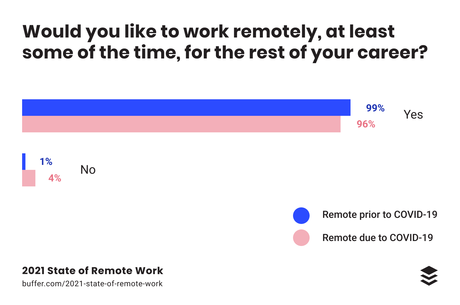Making a smooth transition to remote work has been on the agenda of every team that was displaced from their office during the pandemic. Many have made it work for them while others are still figuring it out.
Upwork, which is a leading platform for remote working professionals, highlighted that by 2028, 73% of all departments are expected to permanently switch to remote work.
This tells us that remote work may have gotten popular due to the inevitability of social distancing but it will stay because it's beneficial. It has direct benefits for organizations, such as savings on renting out large office spaces and not depending upon a limited pool of talent. If we talk about the employees, about 99% would love to work remotely for the rest of their lives.

We're clear on the front that remote work is here to stay. Now it's about adapting to the dynamics of remote work as comfortably and efficiently as possible. For which, most organizations are trying innovative ways.
In order to learn from the best, we gathered expert advice from 8 leading names in the remote work enablement space. These icons have been advocating remote work much before the pandemic, and were, therefore, pretty successful in navigating the uncertainties caused by it.
As someone who wants to establish or improve remote work policies at your own organization, you will find the following pieces of advice pretty useful. From company culture to communication, you'll learn about successful remote work teams around the world, and how you can become one too.
Top 7 Productivity Tips from Remote Working Leaders
"You have to ask a lot of questions because there are a lot of unspoken rules about how work gets done. In a remote setting, you have to convert everything that was tacit to explicit. And there's no great way to do that other than sitting down and truly auditing the way that you work and pressure testing it."1. Darren Murph, Head of Remote Work @ Gitlab, Author of Living the Remote Dream

Darren Murph is one of the pioneers of remote work who has been pushing the idea of remote workplaces long before the pandemic hit the global workforce. He's heading remote work at Gitlab that comprises 1200 fully remote employees and no brick-and-mortar headquarters to name. The overreaching success of Gitlab as an organization that is valued at $6 billion offers a lot to learn about successful remote work.
In his advice, Murph stresses upon two things;
- Understanding that obvious doesn't apply to remote work
- Being ready to make fundamental changes to how your organization works
In a physical office, a lot of things are naturally understood. You don't have to announce that you're going for a stroll in the cafeteria or that you're feeling under the weather today. Anyone who merely glances at you can get that information easily. But all of this changes when you're working virtually.
No one can actually see you working, all they know is that you're online and that you'd respond to a chat message if one was sent. This makes a lot of obvious things a lot less obvious, which is how conflicts and misunderstandings begin to take shape.
This calls for a renewal of work policies. You'd have to build new rules and regulations that can help everyone deal with this unsettling virtual veil. How can you create a general understanding among remote employees of how work is to be done, even if no one is in sight?
Applying Murph's AdviceTo make your work processes smoother, the first thing to do is to establish ground rules of virtual working.
- Set protocols for scheduling meetings, having work chats, or discussing work issues. Let there be a process in place for communicating with fellow workers, such as, "No pings after 6 PM" or "Confirm availability on Slack before calling."
- Leveraging synchronous and asynchronous communication. Zoom meetings are great but a follow-up email on the key decisions made in the meeting is inevitable. Real-time conversations needed to be backed by asynchronous confirmations to make everything apparent.
- Being flexible in working from home and office. Organizations like standardizing shift timings, productive hours, and time-off but remote work is all about embracing flexibility. If people are more productive at night, then be it. Build a process around flexibility rather than curtailing it in the name of productivity.
2. Tracy Brower, Ph.D. sociologist and the author of The Secrets to Happiness at Work

Tracy Brower has extensively studied work habits across industries in her life-long career of being a sociologist. She's a published author with Forbes, The Wall Street Journal, and recipient of the Stanford Alexander Center for Excellence in Real Estate Award. Her book, The Secrets to Happiness at Work sheds light on how to choose and create purpose and fulfillment at work.
In her recommendation, Brower mentions;
It's a well-understood fact that leaders often shape the culture of the organization. A motivated leader who does diligent work and respects the employees no matter where they work from can help build the culture of productivity without enforcing it.
Brower reflects upon making the distance of remote work less of a distance by being actively available for your team and being responsible in handling their challenges. Just like you'd normally do in the office, but with the foresight that remote work may push your employee further from you if you're not proactive.
The effect of leadership on team morale and productivity has been extensively cited by Harvard Business Review. People may underestimate how even little habits of the leader may influence the team members to be more or less engaged at work.
Walking the path of better leadership, she has some nifty points that everyone in the team can learn, to enhance remote team management.
Applying Brower's advice- Spend time knowing your team better. By knowing the individual traits of each employee, you'll be better equipped to solve their respective challenges and guide them better. Remote work doesn't allow for a lot of getting-to-know-each-other, therefore, taking out time to sit with your employees could be a good idea.
- Trusting people with responsibilities. When a new remote employee is hired, it takes some time to develop trust as the natural clues of trustworthiness are missing in a remote environment. By assuming trust in people within safe boundaries, you make them feel valued. Offering the space to be productive and creative, while you meet your core agendas.
- Regular 1:1 meetings help you stay in the loop. Once a week drop-in with each of your employees can help you stay in the loop of things happening at their end, as well as, make yourself more accessible to their issues. It promotes employee-leader connectedness and ensures that very few things slip through the cracks.
- Diligently follow up and be grateful. When a deep conversation is followed up with a "thank you for opening up" email, it helps reduce the virtual wall that often creeps up in remote settings. Being grateful to employees and following up meetings with affirmative messages reinforces communication.
3. Andreas Klinger, CTO at On Deck & Investor at Remote First Capital

Andreas Klinger who now serves as CTO at On Deck has helped remote teams at AngelList and Product Hunt become who they are today. He's a remote work evangelist and startup promoter, offering advice and mentoring to startups around the world. In the investor's seat now, he has some great insights on how to manage remote teams constructively.
In his quote, Klinger sheds light on;
We have already talked about the communication problems that arise when teams are not co-located. No one can naturally guess what the other person is up to, and a task as simple as signing up for the weekend open mic can seem confusing.
Klinger realizes that in order to manage a remote team well, a lot of processes have to be built around even the mundane things that we do in the office. In his words, "Remote teams need 5x the process", which describes the apparent need of converting obvious into explicit.
Applying Klinger's advice
Creating processes can be a hard task for teams who are not habitual to following a guideline for everything. Klinger has some deep advice on how organizations can do this without resistance.
- Make a clearly understandable set of rules for things that matter. Generallyin an organization, being on time for a meeting or not missing a deadline are things that matter a lot. Having a clearly defined set of rules for such activities helps employees not drift from meeting expectations.
Rules can be as simple as, "login 5 minutes before the meeting, submit the status report before logout, acknowledge the minutes-of-meeting broadcast." Just by placing these rules, half the battle is won.
- Be sure of what kind of remote work model you want. Remote teams can be 100% remote, hybrid, or just have some employees working remotely. In order to make remote work fruitful, understand why you need to go remote. Is it because you can't go to the office at all? Or do you need to attract better talent? Or you're looking for cheap outsourcing? Having an awareness of your remote goals will help you strategize better.
- Help your team transition from micro-managed to self-managed. Co-located teams often patch their broken processes using quick-fix micromanagement which is very hard to do remotely. Hence, managers should build a culture where employees are expected to make their own decisions and reach out when help is needed. Self-managed teams have a better chance of surviving remotely.
4. Brie Weiler Reynolds, remote career services and career development manager at FlexJobs.

Brie Reynolds has been working remotely since 2009 and has found a befitting role at FlexJobs which helps organizations hire remote workers. She comes with a lot of experience in the field and understands how the remote industry works on the inside. Being a career coach, she constantly teaches employees and organizations how to do better remote work.
In her approach, Reynolds highlights;
Communicating remotely is a challenge for most teams, no matter how long they have been at it. And this challenge can eat up an individual member's productivity as they're susceptible to feeling alienated due to broken communication.
Here, managers must understand the urgent need of staying in sync with team members in order to keep them engaged. As Reynolds mentioned, you'd probably not go a day without saying hello to your manager in the office. So, why would you create such a distance in a remote setup?
Applying Reynolds' adviceManagers must create a constant flow of communication with their team, but what that entails and how to achieve effective communication without the nags is a challenge. Here's what managers can do.
- Get trained on remote team management. A great idea for managers is to ramp up their management skills for better adapting to remote team challenges. There are several training courses available that will help you be better equipped to handle your team and improve your personal, as well as, the team's performance.
- Creating channels of seamless communication. With more channels of communication, you can make it much easier to reach out to you. For this, you have a variety of options such as Zoom meetings, audio phone calls, messaging apps, and Project Management tools.
- Make communication a must for your team. This is something where you'd have to lead by example. Set examples of taking the initiative to talk it out, converse naturally and build an environment where team communication is robust. Teams who are comfortable communicating are able to solve half the challenges that remote work brings with it.
5. Greg Caplan, Co-founder, and CEO at Spot Meetings

Greg Caplan has co-founded two flourishing companies that focus on making it easier to work remotely. Remote Year, where Caplan spent about 6 years, enables working professionals to travel and work from unique locations around the world. Spot Meetings is another solution that empowers the remote workforce to make meetings easier.
In his quote, Caplan describes the power of being a remote organization;
Hiring and retaining top talent has been one of the evergreen challenges faced by companies. One may think that Frogs (Fully Remote Organizations) may find it difficult to find befitting employees but it's the exact opposite of that. More people than ever are willing to work from their home given a decent salary, and corresponding work flexibility.
Caplan highlights the immense benefit that remote-favoring organizations can derive by hiring remote employees. It's not only about finding and retaining cheap labor but finding the best-fits. When you have the best-fitting people in your team, you automatically ensure that your projects are handled productively.
But how to hire remotely and what challenges can it create for your Human Resource department. Here's how you can overcome them and make it easier to recruit remote talent.
Applying Caplan's adviceCaplan's focus is one of the most difficult areas of remote work, which is finding the right people. He offers insights into how organizations can hire remote talent effectively and maximize team productivity.
- Start by building a sustainable remote work culture. Before you enlist job vacancies all over the internet, you need to have the right remote work policies and tools in place. Plan out how much salaries remote workers will be eligible for, what benefits they'd receive, and how you'd be enabling them to get along with the in-office team.
- Train your recruiters for remote hiring. An important step along the way is to train your recruiters for making the right hiring decisions and understand what candidates to look for. As this may be new for the recruiters also, it's only wise to train them for the job.
- Create attractive remote work packages. Top remote recruiters understand what remote employees will need to fully immerse in their job and it's not just a good salary. You'll have to create a full package consisting of computing hardware, peripherals, internet reimbursement, meal coupons, etc, to ensure that the employees stay engaged as they work remotely.
6. Sandeep Kashyap, Founder, and CEO at ProofHub, a remote team project management software.

Sandeep Kashyap comes with over a decade worth of experience in developing and polishing his homegrown remote team management software. He has a deep understanding of the collaboration challenges faced by remote teams across several industries. The software he has worked upon is used by more than 85,000 teams across the globe, many of which are fully remote organizations.
In his words, Kashyap refers to;
In the wake of the pandemic, we have seen several organizations falter as they were caught off-guard in the most unprecedented ways. But while it became difficult for certain organizations, remote-ready teams who were actively collaborating as a part of their routine work were able to handle the shift much more easily.
The same readiness can help organizations thrive in an uncertain job climate. If your employees can work from anywhere and you're not dependent upon your office for your productivity, you're already miles ahead of others who aren't. And to achieve this, there are handsome tools that can help you overcome existing collaboration challenges.
The key lies in adopting these remote team management tools and building resilience today, to fully realize the benefits of remote work.
Applying Kashyap's adviceThe same productivity that individuals exhibit in an office environment can be replicated in remote work too. Here are a few ways your organization can achieve the same.
- Invest in improving collaboration across teams. Build workflows in your organization, that are collaborative in nature and train your employees to efficiently participate in them. Just the way agile software teams work in tandem with each other, non-technical teams can also use the same principles to boost intra-team collaboration quality.
- Employ the right tools today for far-reaching benefits tomorrow. Using the right tools is extremely important to making collaboration a reality. A disproportionate number of teams struggle simply because they rely on inefficient tools. Use focused tools for every business need to realize the benefits in the long run. Remote technology is a key enabler in remote productivity and organizations must understand how to use it right.
- Promoting remote work at your organization can itself promote productivity. Giving your employees the flexibility they need to lead a balanced life could be a great incentive for productivity. While many employees love working in the office, a timely respite from the daily drudgery can help them gain better control of their lives. With remote-first tools in your arsenal, your employees can enjoy a greater degree of freedom.
7. Steli Efti, CEO of Close.com

Steli Efti is the founder of Close.com which is a sales communication platform built for remote teams. The platform's objective is to make sales an effective process without relying on legacy tools. The team at close.com believes in working remotely and has been built upon some solid principles that organizations wanting to go remote can learn from.
In his insights, Efti talks about;
Culture is an unignorable aspect of any remote team. If the culture isn't suited for an individual, it would be very hard to retain good talent. More so, good culture is one of the biggest motivations for employees to stay productive on their own accord.
Efti talks about shaping culture as one of the ways of sustaining a productive remote team. He converted his entire on-premise office into a fully virtual one slowly by ensuring that the company culture was a fit for the employees. If employees feel safe, valued, and engaged in the company, you'd not have to move mountains to make them productive.
Applying Efti's advice
In remote settings, taking care of the culture can be a bit hard as the mutual connection is mostly virtual. But there are ways with which company leaders can change the culture for good.
- Build a culture of care for all remote employees. Well-cared-foremployees could turn into your biggest asset at the organization. Understanding challenges, finding solutions, and laying your trust in your remote employees are fundamental to building a culture of care. Reach out to your team members, see what is irking them and invest in their well-being before they succumb to their issues.
- Overcommunication isn't that bad. Remote communication often comes with the risk of under-communication as there's always a virtual veil among team members. Overcommunication can help everyone be on the same page as frequently as possible and not give into confusion. Obviously, overcommunication doesn't mean pestering each other with messages but deciding to communicate as much as you can to leave no doubt unaddressed.
- Look for people who match the vibe and core of your company. Choosing the right people to work with, could take care of many challenges of remote work. If you could find professionals who enjoy flexibility as much as you do and are willing to give their 100% even from home, you won't have to worry about productivity dips so much. Finding and hiring people who vibe with your company is an important first step.
We have listened to some of the most influential personalities who have contributed a lot to making remote teams successful. Their opinions and suggestions are extremely valuable in understanding the future of work which undeniably will comprise remote work in large chunks.
Another thing that is clear with all the testimonies is that there is no surefire formula when it comes to making remote work productive. Each company learns to do so by experimenting and iterating. While that's not bad, it's always good to take advice from someone who's been there and done that.
Organizations that want to introduce remote work at their workplaces or are looking to go fully remote must pay close heed to all the advice in this article. All of the quotes stem from real-life experiences and there's a lot to learn from each individual who has been making remote work rewarding for their team.
